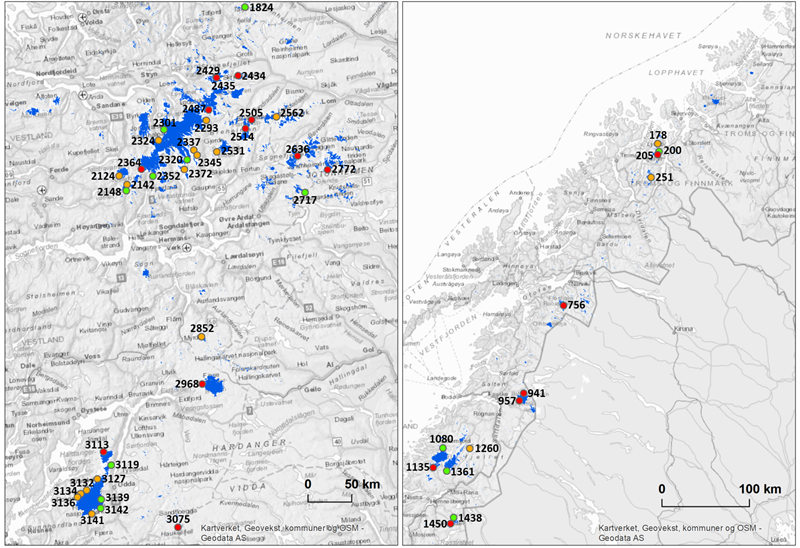Jøkulhlaup (GLOF)
A jøkulhlaup or Glacier Lake Outburst Flood (GLOF) is a sudden release of water from a glacier.
The sudden release of water from a glacier is called a jøkulhlaup or Glacier Lake Outburst Flood (GLOF). The water source can be a glacier-dammed lake, a pro-glacial moraine-dammed lake or water stored within, under or on the glacier. Once the water finds a way over, underneath or through the dam, large parts of the lake can be emptied in a short time (hours to days) resulting in violent floods. Such floods have caused considerable damage in the past. The term jøkulhlaup is Icelandic in origin (from the Icelandic jøkull = glacier, and hlaup = flood burst).
One way to reduce the risk of such a flood is the controlled drainage of the trapped water through artificial spillways or tunnels, either to empty the lake or to lower its level below a critical level. This has been done several glacier-dammed lakes, including at Demmevatnet (Hardangerjøkulen) and at Austerdalsisen (Svartisen).
In cases where there is no mitigation work carried out and there is thought to be potential for a glacier flood, then the glacier lake should be monitored closely. NVEs use satellite imagery to survey glacier lakes with previously registered GLOFs and detect new possible GLOF sites.

Overview of active (red), potential (green) and historic (orange) GLOF sites in Norway as of January 2022.
Jøkulhlaups in Norway in recent years
- Øvre Messingmalmvatnet at Rundvassbreen, Blåmannsisen in Nordland
- Nupsfonn in the county of Vestland, northwest of Ståvatnet.
- Demmevatnet at Rembesdalskåka (an outlet glacier of Hardangerjøkulen) in Eidfjord, Hordaland.
- Harbardsbreen in Luster, Sogn og Fjordane
- Koppangsbreen in Lyngen
- Tystigbreen in Stryn
- Flatbrevatnet at Flatbreen, Jostedalsbreen in Sogndal, Sogn og Fjordane
- Heiavatnet at Svartisheibreen, Vestre Svartisen in Rana, Nordland
Selected sources descibing glacier lakes and jokulhlaup events in Norway
https://glacier.nve.no/Glacier/viewer/GLOF/en/ (overview of recorded events in Norway )
Andreassen, L.M. (ed.), G. Moholdt, A. Kääb, A. Messerli, T. Nagy & S.H. Winsvold. 2021. Monitoring glaciers in mainland Norway and Svalbard using Sentinel. NVE Rapport 3-2021, 94 s.
Engeset, R. V., T. V. Schuler and M. Jackson. 2005. Analysis of the first jökulhlaup at Blåmannsisen in northern Norway and implications for future events. Annals of Glaciology, 42, 35-41.
Elvehøy, H., J. Kohler, R. Engeset & L.M. Andreassen, 1997. Jøkullaup fra Demnevatn. NVE Rapport nr. 17, 36 s.
Jackson, M. &G. Ragulina. 2014. Inventory of glacier-related hazardous events. NVE Report 83-2014, 221 s.
Liestøl, O. 1956. Glacier dammed lakes in Norway. Norsk geografisk tidsskrift, Bind 15, s. 122-149.
Other
Glacier inventory & GlacierIV (BreID): Andreassen, L. M., S. H. Winsvold (eds.), F. Paul and J.E. Hausberg. 2012. Inventory of Norwegian glaciers. NVE Report 38-2012, 236 s.
Digital glacier map: NVEs temakart for bre shows glaciers, glacier lakes, glacier IDs (BreID) and FLOFs and ice avalanche events. Updated annually.
Gridabase is a database with information on glacier-related events and accidents that was established in the EU project Glaciorisk (2001-03). NVE and the Department of Geosciences in the University of Oslo participated in the project, as well as groups in Iceland, France, Switzerland and Italy. Note that the database is not updated with newer events in Norway.

